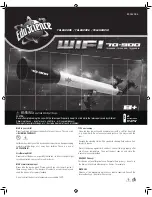
15
allow an hour or more. In the winter, storing the telescope out-
doors in a shed or garage greatly reduces the amount of time
needed for the optics to stabilize. It also is a good idea to keep
the scope covered until the Sun sets so the tube does not
heat greatly above the temperature of the outside air.
Youc an attach a small fan to the Atlas 10 EQ to make cooling
the tube faster. On the bottom of the mirror cell there are four
holes (M4x.7 thread) where a fan can be mounted.
D. Let Your Eyes Dark-Adapt
Do not expect to go from a lighted house into the darkness of
the outdoors at night and immediately see faint nebulas,
galaxies, and star clusters—or even very many stars, for that
matter. Your eyes take about 30 minutes to reach perhaps
80% of their full dark-adapted sensitivity. Many observers
notice improvements after several hours of total darkness. As
your eyes become dark-adapted, more stars will glimmer into
view and you will be able to see fainter details in objects you
view in your telescope. Exposing your eyes to very bright day-
light for extended periods of time can adversely affect your
night vision for days. So give yourself at least a little while to
get used to the dark before you begin observing.
To see what you are doing in the darkness, use a red-filtered
flashlight rather than a white light. Red light does not spoil
your eyes’ dark adaptation like white light does. A flashlight
with a red LED light is ideal, or you can cover the front of a
regular incandescent flashlight with red cellophane or paper.
Beware, too, that nearby porch and streetlights and automo-
bile headlights will spoil your night vision.
Eyepiece Selection
By using eyepieces of varying focal lengths, it is possible to
attain many magnifications with the Atlas 10 EQ. The tele-
scope comes with two high-quality Sirius Plössl eyepieces: a
25mm, which gives a magnification of 48x, and a 10mm,
which gives a magnification of 120x. Other eyepieces can be
used to achieve higher or lower powers. It is quite common for
an observer to own five or more eyepieces to access a wide
range of magnifications. This allows the observer to choose
the best eyepiece to use depending on the object being
viewed. At least to begin with, the two supplied eyepieces will
suffice nicely.
Whatever you choose to view, always start by inserting your
lowest power (longest focal length) eyepiece to locate and
center the object. Low magnification yields a wide field of
view, which shows a larger area of sky in the eyepiece. This
makes acquiring and centering an object much easier. If you
try to find and center objects with high power (narrow field of
view), it’s like trying to find a needle in a haystack!
Once you’ve centered the object in the eyepiece, you can
switch to higher magnification (shorter focal length eyepiece),
if you wish. This is especially recommended for small and
bright objects, like planets and double stars. The Moon also
takes higher magnifications well.
Deep-sky objects, however, typically look better at medium or
low magnifications. This is because many of them are quite
faint, yet have some extent (apparent width). Deep-sky
objects will often disappear at higher magnifications, since
greater magnification inherently yields dimmer images. This
is not the case for all deep-sky objects, however. Many galax-
ies are quite small, yet are somewhat bright, so higher power
may show more detail.
The best rule of thumb with eyepiece selection is to start with
a low power, wide field, and then work your way up in magni-
fication. If the object looks better, try an even higher magnifi-
cation. If the object looks worse, then back off the magnifica-
tion a little by using a lower power eyepiece.
What to Expect
So what will you see with your telescope? You should be able
to see bands on Jupiter, the rings of Saturn, craters on the
moon, the waxing and waning of Venus, and thousands of
deep sky objects. Do not expect to see as much color as you
in NASA photos, since those are taken with long-exposure
cameras and have “false color” added. Our eyes are not sen-
sitive enough to see color in deep-sky objects except in a few
of the brightest ones.
Remember that you are seeing these objects using your own
telescope with your own eyes! The object you see in your eye-
piece is in real-time, and not some conveniently provided
image from an expensive space probe. Each session with
your telescope will be a learning experience. Each time you
work with your telescope it will get easier to use, and stellar
objects will become easier to find. Take it from us, there is big
difference between looking at a well-made full-color NASA
image of a deep-sky object in a lit room during the daytime,
and seeing that same object in your telescope at night. One
can merely be a pretty image someone gave to you. The other
is an experience you will never forget!
A. The Moon
With is rocky and cratered surface, the moon is one of the
most interesting and easy subjects for your scope. The best
time to view it is during its partial phases when shadows fall
on the craters and canyon walls to give its features definition.
While the full moon may look like a tempting target, it is actu-
ally the worst time for viewing! The light of a full moon is too
bright and lacks any decent surface definition.
Use an optional Moon filter to dim the Moon when it is very
bright. It simply threads onto the bottom of the eyepiece from
the focuser (you must first remove the eyepiece from the
focuser to attach the filter). You’ll find the Moon filter improves
viewing comfort, and helps bring out the subtle features if the
lunar surface.
B. The Sun
You can change your nighttime telescope into a daytime Sun
viewer by installing an optional full-aperture solar filter over
the front opening of a Atlas 10 EQ. The primary attraction is
sunspots, which change shape, appearance, and location
daily. Sunspots are directly related to magnetic activity in the
Sun. Many observers like to make drawings of sunspots to
monitor how the Sun is changing from day to day.
Important Note: Do not look at the Sun with any optical
instrument without a professionally made solar filter, or






































